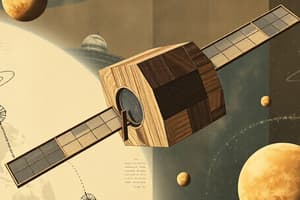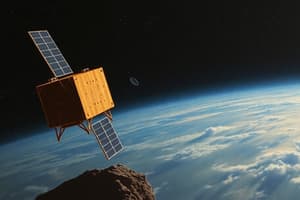Podcast
Questions and Answers
What is the primary mission of LignoSat?
What is the primary mission of LignoSat?
- To investigate the effects of space on aluminum.
- To explore environmentally friendly fuel sources.
- To determine if wood can withstand the conditions of space. (correct)
- To develop new rocket science technologies.
What material has LignoSat been constructed from?
What material has LignoSat been constructed from?
- Wood from magnolia trees. (correct)
- Aluminum and plastic.
- Synthetic polymers.
- Recycled materials.
What environmental problem does the use of wooden satellites aim to address?
What environmental problem does the use of wooden satellites aim to address?
- Pollution caused by rocket launch sites.
- Reduction of space junk and harmful emissions. (correct)
- Decreasing funding for space exploration.
- Overpopulation of the ISS.
How long did the panel of wood samples remain in space before being returned for analysis?
How long did the panel of wood samples remain in space before being returned for analysis?
Which institutions collaborated on the LignoSat Space Wood Project?
Which institutions collaborated on the LignoSat Space Wood Project?
What is a potential future benefit of successful wooden satellite testing?
What is a potential future benefit of successful wooden satellite testing?
What happens to LignoSat after its six-month mission?
What happens to LignoSat after its six-month mission?
Why do engineers traditionally consider wood to be unsuitable for aerospace technology?
Why do engineers traditionally consider wood to be unsuitable for aerospace technology?
Flashcards
LignoSat
LignoSat
The world's first satellite made primarily from wood, designed to assess the viability of wood in space.
LignoSat Space Wood Project
LignoSat Space Wood Project
A collaborative project between Kyoto University and Sumitomo Forestry aiming to utilize wood in space.
Space Junk
Space Junk
The process of a satellite entering Earth's atmosphere and burning up, releasing harmful particles that can damage the ozone layer.
Magnolia Wood
Magnolia Wood
Signup and view all the flashcards
Growing Trees in Space
Growing Trees in Space
Signup and view all the flashcards
Environmentally-friendly Spacecraft
Environmentally-friendly Spacecraft
Signup and view all the flashcards
Wood in Space
Wood in Space
Signup and view all the flashcards
Future of Wooden Satellites
Future of Wooden Satellites
Signup and view all the flashcards
Study Notes
LignoSat - A Wooden Satellite for Space
- LignoSat, the world's first largely wooden satellite, arrived at the ISS aboard a SpaceX cargo capsule on November 5, 2024.
- It's named after the Latin word for "wood" and slated for launch into orbit later in November.
- The mission: assess wood's suitability for harsh space conditions. Success could lead to sustainable spacecraft.
- Collaboration between Kyoto University and Sumitomo Forestry.
- Preliminary testing: A panel with three wood samples was sent to the ISS in 2022, exposing it to space for ten months. Analysis led to selecting magnolia wood for LignoSat.
Rationale for Wooden Satellites
- Current satellites mostly consist of aluminum, which, during atmospheric re-entry, releases aluminum oxide particles, a potential ozone layer threat.
- Wooden satellites, breaking down to simpler water and carbon dioxide, reduce this harmful effect, combating space debris.
- Potential long-term implications: Growing trees in space (Moon/Mars).
LignoSat's Mission and Future
- LignoSat will orbit Earth for 6 months, collecting crucial data about wood's behavior in space.
- The gathered data will inform future designs for larger-scale wooden satellites and devices, showcasing the potential of timber in the space age.
- A key driver for the project is to lessen space junk and its environmental impact.
Studying That Suits You
Use AI to generate personalized quizzes and flashcards to suit your learning preferences.




